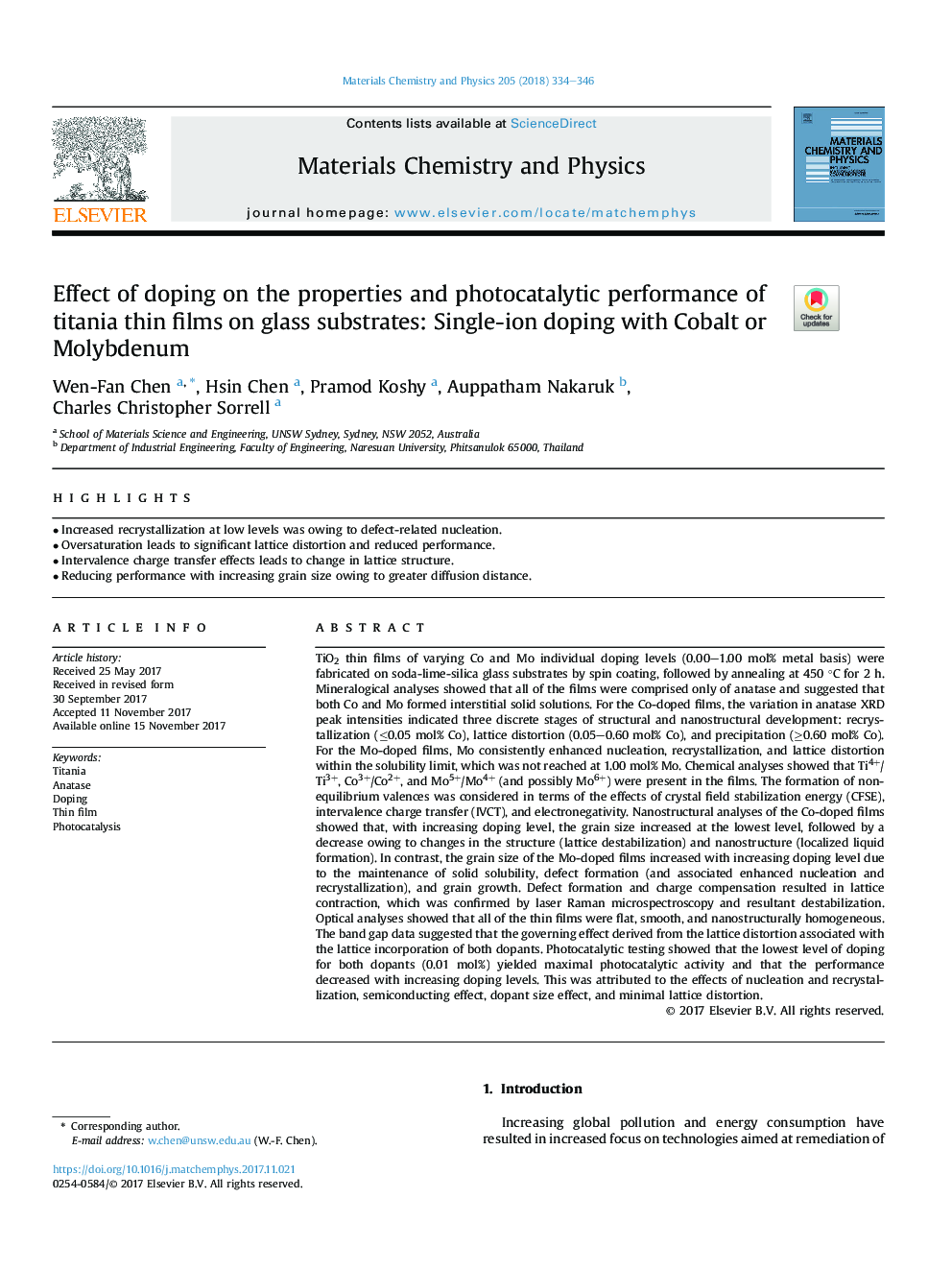| کد مقاله | کد نشریه | سال انتشار | مقاله انگلیسی | نسخه تمام متن |
|---|---|---|---|---|
| 7922393 | 1511758 | 2018 | 13 صفحه PDF | دانلود رایگان |
عنوان انگلیسی مقاله ISI
Effect of doping on the properties and photocatalytic performance of titania thin films on glass substrates: Single-ion doping with Cobalt or Molybdenum
ترجمه فارسی عنوان
اثر دوپینگ بر روی خواص و عملکرد فوتوکاتالیستی فیلم های نازک تیتانی بر روی زیربناهای شیشه ای: دوپینگ تک یونی با کبالت یا مولیبدن
دانلود مقاله + سفارش ترجمه
دانلود مقاله ISI انگلیسی
رایگان برای ایرانیان
کلمات کلیدی
تیتانیا، آناتاز، دوپینگ فیلم نازک، فوتوکاتالیز،
موضوعات مرتبط
مهندسی و علوم پایه
مهندسی مواد
مواد الکترونیکی، نوری و مغناطیسی
چکیده انگلیسی
TiO2 thin films of varying Co and Mo individual doping levels (0.00-1.00 mol% metal basis) were fabricated on soda-lime-silica glass substrates by spin coating, followed by annealing at 450 °C for 2 h. Mineralogical analyses showed that all of the films were comprised only of anatase and suggested that both Co and Mo formed interstitial solid solutions. For the Co-doped films, the variation in anatase XRD peak intensities indicated three discrete stages of structural and nanostructural development: recrystallization (â¤0.05 mol% Co), lattice distortion (0.05-0.60 mol% Co), and precipitation (â¥0.60 mol% Co). For the Mo-doped films, Mo consistently enhanced nucleation, recrystallization, and lattice distortion within the solubility limit, which was not reached at 1.00 mol% Mo. Chemical analyses showed that Ti4+/Ti3+, Co3+/Co2+, and Mo5+/Mo4+ (and possibly Mo6+) were present in the films. The formation of non-equilibrium valences was considered in terms of the effects of crystal field stabilization energy (CFSE), intervalence charge transfer (IVCT), and electronegativity. Nanostructural analyses of the Co-doped films showed that, with increasing doping level, the grain size increased at the lowest level, followed by a decrease owing to changes in the structure (lattice destabilization) and nanostructure (localized liquid formation). In contrast, the grain size of the Mo-doped films increased with increasing doping level due to the maintenance of solid solubility, defect formation (and associated enhanced nucleation and recrystallization), and grain growth. Defect formation and charge compensation resulted in lattice contraction, which was confirmed by laser Raman microspectroscopy and resultant destabilization. Optical analyses showed that all of the thin films were flat, smooth, and nanostructurally homogeneous. The band gap data suggested that the governing effect derived from the lattice distortion associated with the lattice incorporation of both dopants. Photocatalytic testing showed that the lowest level of doping for both dopants (0.01 mol%) yielded maximal photocatalytic activity and that the performance decreased with increasing doping levels. This was attributed to the effects of nucleation and recrystallization, semiconducting effect, dopant size effect, and minimal lattice distortion.
ناشر
Database: Elsevier - ScienceDirect (ساینس دایرکت)
Journal: Materials Chemistry and Physics - Volume 205, 1 February 2018, Pages 334-346
Journal: Materials Chemistry and Physics - Volume 205, 1 February 2018, Pages 334-346
نویسندگان
Wen-Fan Chen, Hsin Chen, Pramod Koshy, Auppatham Nakaruk, Charles Christopher Sorrell,
